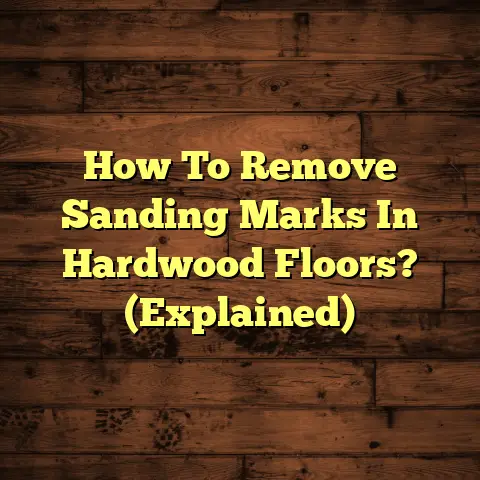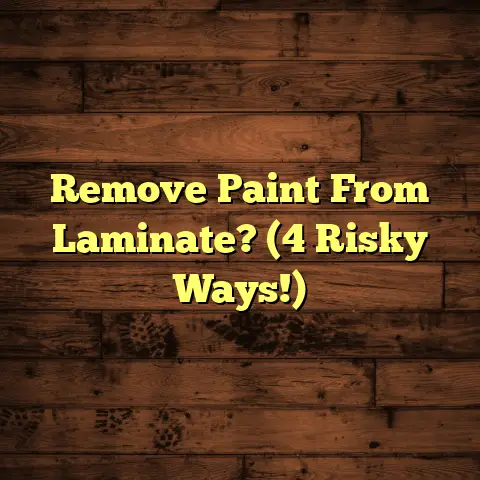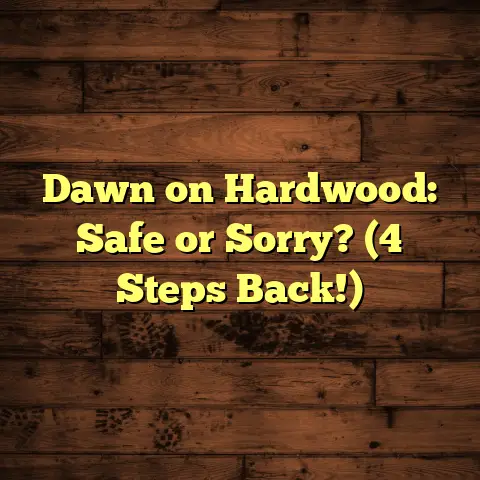Carpet Padding Truth Explained (7 Things to Know!)
I’m a flooring contractor with years of experience, and I’m here to spill the beans on something that often gets overlooked: carpet padding.
Trust me, it’s way more important than you think!
Most folks focus on the carpet itself – the color, the texture, the price.
But guess what? The padding underneath is the unsung hero that can make or break your flooring experience.
Think of it as the foundation of your carpet.
It’s what gives you that plush, comfy feeling underfoot, helps with soundproofing, and even extends the life of your carpet.
It’s super customizable, too!
You can really tailor it to fit your needs.
I’ve seen firsthand how the right padding can transform a room.
But I’ve also seen the consequences of choosing the wrong one.
That’s why I’m here to share seven essential truths about carpet padding that every homeowner should know.
Let’s dive in!
1. What is Carpet Padding?
Okay, let’s start with the basics.
What exactly is carpet padding?
Simply put, it’s a layer of material installed between your subfloor and your carpet.
Its primary role is to provide cushioning, support, and insulation.
But it’s not just one-size-fits-all.
Carpet padding comes in various materials, each with its own set of pros and cons.
Here are some common types:
-
Foam: This is probably the most common type.
It’s affordable and comes in different densities.
You’ll find everything from basic polyurethane foam to memory foam for extra comfort.
-
Rubber: Rubber padding is known for its durability and resilience.
It’s a great choice for high-traffic areas.
There are two main types: waffle rubber and flat rubber.
-
Fiber: Fiber padding is made from natural or synthetic fibers, like jute or recycled materials.
It’s a good eco-friendly option and provides firm support.
Each of these materials affects performance differently.
For example, a dense rubber pad will offer excellent support and durability.
But it might not be as plush as a memory foam pad.
I’ve seen homeowners choose a super-soft pad for a bedroom.
While opting for a denser, more resilient one in a hallway.
It really depends on your needs and preferences!
The type of padding you choose can really be tailored to fit various needs.
It can make a big difference in how your carpet feels and performs.
2. The Importance of Carpet Padding
So, why is carpet padding so important anyway?
Well, for starters, it provides that oh-so-comfortable feeling underfoot.
Who doesn’t love sinking their toes into a plush carpet?
But it’s more than just comfort.
Carpet padding also acts as an insulator, helping to keep your home warm in the winter and cool in the summer.
That can translate to lower energy bills!
And let’s not forget about noise reduction.
Padding absorbs sound, making your home quieter and more peaceful.
I’ve had clients tell me that adding padding was like adding a layer of serenity to their homes.
But perhaps the most important benefit of carpet padding is that it extends the life of your carpet.
It acts as a shock absorber, protecting your carpet fibers from wear and tear.
Without padding, your carpet would wear out much faster.
Think about it this way: every time you walk on your carpet, the fibers are compressed against the hard subfloor.
Over time, this can cause them to break down and flatten.
Padding cushions the impact, preventing damage and prolonging the life of your carpet.
In fact, according to the Carpet and Rug Institute (CRI), using the right carpet padding can extend the life of your carpet by as much as 50%!
That’s a huge savings in the long run.
3. Choosing the Right Thickness
Okay, let’s talk about thickness.
How thick should your carpet padding be?
Well, it depends on a few factors, including the type of carpet you have and where it’s being installed.
Industry standards typically range from 1/4 inch to 1/2 inch.
But there are exceptions.
For example, a thinner pad (around 1/4 inch to 3/8 inch) is often recommended for berber carpets.
This is because berber carpets have a tight, low pile.
A thicker pad can actually cause them to stretch and wrinkle.
On the other hand, a thicker pad (around 1/2 inch) is often a good choice for plush carpets.
It provides extra cushioning and support, enhancing the overall comfort.
I’ve seen homeowners make the mistake of choosing a pad that’s too thick for their carpet.
This can lead to problems like difficulty opening doors and uneven wear.
It’s important to consult with a flooring professional to determine the right thickness for your specific carpet.
Here’s a quick guide:
| Carpet Type | Recommended Padding Thickness |
|---|---|
| Berber | 1/4 inch to 3/8 inch |
| Plush | 1/2 inch |
| Loop Pile | 3/8 inch to 1/2 inch |
These are general guidelines, of course.
Your specific needs may vary.
4. Density Matters
Now, let’s talk about density.
Density refers to the amount of material packed into a given volume of padding.
It’s measured in pounds per cubic foot.
The higher the density, the more durable and supportive the padding will be.
Low-density padding (less than 6 pounds per cubic foot) is typically less expensive.
But it also tends to wear out faster.
It may be suitable for low-traffic areas like bedrooms.
High-density padding (8 pounds per cubic foot or more) is more expensive.
But it offers superior support and durability.
It’s a good choice for high-traffic areas like hallways and living rooms.
I always tell my clients to pay attention to density.
It’s a key indicator of quality.
A high-density pad will not only feel better underfoot.
But it will also protect your carpet from wear and tear.
Here’s a simple way to assess density: pick up a sample of the padding and squeeze it.
If it feels flimsy and easily compressed, it’s probably low-density.
If it feels firm and resilient, it’s likely high-density.
Don’t be afraid to ask your flooring retailer about the density of the padding you’re considering.
They should be able to provide you with the specifications.
5. Carpet Padding and Warranty
Did you know that your carpet padding can affect your carpet warranty?
It’s true!
Most carpet manufacturers require you to use a specific type of padding in order to maintain your warranty coverage.
If you use the wrong padding, you could void your warranty.
That means if your carpet develops a defect, the manufacturer won’t be responsible for fixing it.
I’ve seen homeowners get burned by this.
They choose a cheap padding to save money.
Only to find out later that it voided their warranty.
It’s always a good idea to check your carpet warranty before choosing padding.
Pay close attention to the manufacturer’s recommendations.
They may specify a minimum density or thickness.
They may also recommend a particular type of padding, such as rubber or foam.
If you’re not sure which padding to choose, ask your flooring retailer for help.
They should be familiar with the warranty requirements of different carpet manufacturers.
Here are some common warranty stipulations:
-
Minimum Density: Many warranties require a minimum density of 6 pounds per cubic foot.
-
Maximum Thickness: Some warranties specify a maximum thickness to prevent stretching and wrinkling.
-
Padding Type: Some warranties require a specific type of padding, such as rubber or foam.
Choosing the right padding is an investment in your carpet.
It protects your warranty and ensures that your carpet will last for years to come.
6. Environmental Impact
In today’s world, it’s important to consider the environmental impact of our choices.
That includes carpet padding.
Fortunately, there are many eco-friendly options available on the market.
One popular option is recycled carpet padding.
This type of padding is made from recycled materials, such as plastic bottles or old tires.
It’s a great way to reduce waste and conserve resources.
Another eco-friendly option is natural fiber padding.
This type of padding is made from natural fibers, such as jute or wool.
It’s biodegradable and sustainable.
I’ve seen a growing demand for eco-friendly carpet padding in recent years.
Homeowners are becoming more aware of the environmental impact of their choices.
They’re looking for ways to reduce their carbon footprint.
Here are some things to look for when choosing eco-friendly carpet padding:
-
Recycled Content: Look for padding made from a high percentage of recycled materials.
-
Natural Fibers: Choose padding made from natural fibers, such as jute or wool.
-
Low VOCs: Look for padding that emits low levels of volatile organic compounds (VOCs).
Choosing eco-friendly carpet padding is a win-win.
It’s good for the environment and it’s good for your home.
7. Installation and Maintenance
Okay, let’s talk about installation and maintenance.
Proper installation is crucial for ensuring that your carpet padding performs as it should.
It’s important to hire a qualified installer who knows how to properly install carpet padding.
The installer should start by preparing the subfloor.
This may involve cleaning, leveling, and repairing any damage.
Next, the installer will cut the padding to size and secure it to the subfloor.
They may use staples, glue, or tape.
Finally, the installer will install the carpet over the padding.
Proper maintenance is also important for prolonging the life of your carpet padding.
Here are some tips:
-
Vacuum Regularly: Vacuum your carpet regularly to remove dirt and debris.
This will prevent dirt from getting trapped in the padding.
-
Clean Spills Immediately: Clean up spills immediately to prevent stains and odors.
-
Professional Cleaning: Have your carpets professionally cleaned every 12-18 months.
I’ve seen homeowners neglect their carpet padding.
This can lead to problems like mold growth, odors, and premature wear.
By following these simple maintenance tips, you can keep your carpet padding in good condition for years to come.
Conclusion
So, there you have it: seven essential truths about carpet padding.
I hope this article has shed some light on this often-overlooked aspect of flooring.
Remember, carpet padding is more than just a cushion.
It’s an investment in your comfort, your home’s energy efficiency, and the longevity of your carpet.
Don’t skimp on padding!
Take the time to research your options and choose the right padding for your needs.
Consider the thickness, density, material, and environmental impact.
And don’t forget to check your carpet warranty.
With the right carpet padding, you can transform your home into a comfortable and inviting oasis.
It’s the foundation of a happy home, one step at a time.





